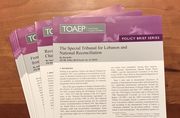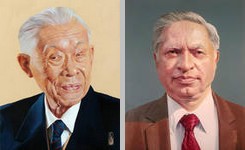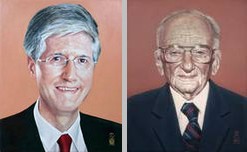Table of contents:
3. The perpetrator killed or injured one or more persons.
P.1.1. Evidence of brutal mistreatment.
P.1.3. Evidence of wounding by firing.
P.2. Evidence of killing by shooting.
P.2.1. Evidence of a summary execution.
P.2.2. Evidence of ordering to refrain from protecting a prisoner from being shot.
P.2.3. Evidence of ordering the shooting of survivors of a sunken ship.
P.2.4. Evidence of shooting down a parachutist.
P.3. Evidence of killing by throwing grenades.
P.4. Evidence of killing by stabbing to death.
P.5. Evidence of ordering to give no quarter.
P.5.1. Evidence of re-issuing superior orders to kill the adversary after capture.
Element:
3. The perpetrator killed or injured one or more persons.
A. Evidentiary comment:
Michael Cottier submits that: "the actus reus of the war crime of killing or wounding persons hors de combat may include a failure to fulfill a duty75, when the fulfillment of the duty was required and possible. However, this should only applied to qualified duties, such as the duty to search for shipwrecked, wounded and sick on the sea, the provision of medical care to wounded and sick when required, and the fundamental obligations towards prisoners of war that parties to the conflict have. Withholding medical care to wounded adversaries or food to prisoners of war, or inflicting other severe conditions of life on prisoners of war might be subsumed under article 82(b)(iv), if committed with the intent of causing death or wounds. The intent can be inferred if the foreseeable consequence of such failure to fulfill a duty is death or wounds76."(Michael Cottier in Triffterer (ed.), Commentary on the Rome Statute of the International Criminal Court, Article 8, para. 68).
"75See Proposal submitted by the United States of America to the Preparatory Commission for the International Criminal Court, Draft elements of crimes, U.N. Doc. PCNICC/1999/DP.$/Add.2 (4 Feb. 1999), pp. 4 and 10. The question of committing a crime by omission is not regulated by the Statute because delegations could not reach any agreement on the question, not because omission was intended to be excluded.
76 Ibid."
P.1.1. Evidence of brutal mistreatment.
A. Legal source/authority and evidence:
Prosecutor v. Mladen Naletilić and Vinko Martinović, Case No. IT-98-34-T, Judgement (TC), 31 March 2003, para. 238:
"238. [ ]. Detained BH Muslim civilians and BH Muslim soldiers hors de combat were often subjected to humiliating and brutal mistreatment by soldiers who had unfettered access to the detention facilities."
P.1.3. Evidence of wounding by firing.
A. Legal source/authority and evidence:
Trial of Helmuth Von Ruchteschell, LRTWC, UNWCC, Vol. IX, p. 82:
"The Prosecution alleged that the Davisian, a British merchant vessel, was attacked in daylight, without warning, by a German armed raider commanded bby the accused on 10th July, 1940. The attacker destroyed her wireless aerial with his first salvo. He maintained heavy fire for about five minutes and then signalled "use your radio not". The captain of the Davisian stopped his engines, hoisted an answering pennant and acknowledged the signal. In spite of this, the raiders firing continued for 15 minutes, wounding 8 or 10 of the crew of the Davisian, whilst they were trying to abandon the ship. The crew were later picked up by the raider."
P.2. Evidence of killing by shooting.
P.2.1. Evidence of a summary execution.
A. Legal source/authority and evidence:
The Dostler Case, LRTWC, UNWCC, Vol. I, p. 23:
"Anton Dostler was charged with violations of the laws of war in that, as commander of the 75th German Army Corps, he, on or about 24th March, 1944, in the vicinity of La Spezia, Italy, ordered to be shot summarily a group of United States Army personnel consisting of two officers and 13 enlisted men, who had then recently been captured by forces under General Dostler, which order was carried into execution on or about 26th March, 1944, resulting in the death of the said 15 members of the United States Army."
Trial of Robert Wagner, LRTWC, UNWCC, Vol. III, p. 32-33:
"On 7th October, 1944, four unknown British airmen made a forced landing at Rheinweiller in Alsace. They were arrested by German pioneers and taken to the town hall. The gendarmerie station at Schlingen was informed of the incident and a detachment of gendarmes led by the ma?tre gendarme Reiner went to Rheinweiller to take charge of the prisoners. On their arrival, they found the captured men outside the town hall, surrounded by a crowd which was said to have been "curious rather than hostile" and were faced with the fact that Grüner, Kreisleiter of Thann and Lorrach, had taken control of the situation. Reiners plan was to take the prisoners to the gendarmerie barracks and to arrange for them to be taken over by the military authorities. Grüner, however, prevented him from doing so. The account given in the Indictment of the events that followed was based mainly on depositions made by Grüner himself in the course of the Preliminary Enquiry. Grüner had told the gendarmes that he was under orders from Wagner to shoot every Allied airman that was captured. He had then ordered the prisoners to be marched off one by one each escorted by a German, and the groups to keep a distance of 50 m. from one another. He had then followed the procession in his car, had taken each prisoner separately to the banks of the Rhine and had shot them with his own mitraillette, which he declared to have always carried with him. The bodies of the murdered men were thrown into the river. Grüner withdrew part of his admission during his interrogation saying that the actual shots had been fired by another person ;[ ]"
The Dreierwalde Case, LRTWC, UNWCC, Vol. I, p.82-83:
"[ ] During a severe air raid made in the vicinity of the Aerodrome on the 21st March, 1945, the four deceased allied prisoners of war, together with Flight-Lieutenant Berick of the Royal Australian Air Force, were forced to bale out, and were on capture taken to the Aerodrome. Towards the evening of the 22nd March, a party, consisting of Amberger in charge, and two German N.C.O.s, set off ostensibly to conduct the five prisoners of war to a railway station for the purpose of taking them to a Prisoner of War Camp or Interrogation Centre. After going about a mile and a half the party turned on to a track leading into a wood. Here, despite the fact that the prisoners were proceeding with decorum, the three N.C.O.s, including Amberger, began firing on them. All were killed except Flight-Lieutenant Berick, who escaped, though wounded. The case for the Prosecution was that the prisoners made no attempt to escape, and that the shooting was cold and calculated murder."
P.2.2. Evidence of ordering to refrain from protecting a prisoner from being shot.
A. Legal source/authority and evidence:
The Essen Lynching case, LRTWC, UNWCC, Volume I, p. 88:
"Heyer, a Captain in the German Army, gave instructions that a party of three Allied prisoners of war were to be taken to a Luftwaffe unit for interrogation. He ordered the escort not to interfere if civilians should molest the prisoners, while also saying that they ought to be shot, or would be shot. A German private was charged with having refrained from interfering with a crowd which murdered the prisoners, although entrusted with their custody. The remaining accused were German civilians who were alleged to have committed the killing. Heyer and one civilian were sentenced to death. The private and two further civilians were sentenced to terms of imprisonment. The remaining two civilians were acquitted."
P.2.3. Evidence of ordering the shooting of survivors of a sunken ship.
A. Legal source/authority and evidence:
The Peleus Trial, Trial of Kapit?nleutnant Heinz Eck and Four Others for the Killing of Members of the Crew of the Greek Steamship Peleus, Sunk on the High Seas, LRTWC, UNWCC, Vol. I, p.3, 16:
"[ ]the accused captain of the U-boat, Eck, had ordered the shooting and the throwing of hand grenades at the rafts and the floating wreckage". [ ]
[The Judge Advocate went on to refuse the defence of operational necessity]:
"The case contains, therefore, no decision on the question whether or to what extent operational necessity legalizes acts of cruelty such as shooting at helpless survivors of a sunken ship because on the facts of the case this behavior was not operationally necessary, i.e. the operational aim, the saving of ship and crew, could have been achieved more effectively without such acts of cruelty."
P.2.4. Evidence of shooting down a parachutist.
A. Legal source/authority and evidence:
Trial of Peter Back, LRTWC, UNWCC, Vol. III, p. 60:
"It was charged that Peter Back, a German civilian, "did, at or near Preist, Germany, on or about 15th August, 1944, violate the laws and usages of war by wilfully, deliberately and feloniously killing an American airman, name and rank unknown, a member of the Allied Forces, who had parachuted to earth at said time and place in hostile territory and was then without any means of defence.""
P.3. Evidence of killing by throwing grenades.
A. Legal source/authority and evidence:
The Peleus Trial, Trial of Kapit?nleutnant Heinz Eck and Four Others for the Killing of Members of the Crew of the Greek Steamship Peleus, Sunk on the High Seas, LRTWC, UNWCC, Vol. I, p.3, 16:
"[ ]the accused captain of the U-boat, Eck, had ordered the shooting and the throwing of hand grenades at the rafts and the floating wreckage". [ ]
P.4. Evidence of killing by stabbing to death.
A. Legal source/authority and evidence:
The Jaluit Atoll Case, LRTWC, UNWCC, Vol. I, p. 72:
"The charge against the accused [ ] was one of murder. The specification stated that they "did, on or about 10th March, 1944, on the Island of Aineman, Jaluit Atoll, Marshall Islands, at a time when a state or war existed between the United States of America and the Japanese Empire, wilfully, feloniously, with malice aforethought without justifiable cause, and without trial or other due process, assault and kill, by shooting and stabbing to death, three American fliers, then and there attached to the Armed forces of the United States of Americain, and then and there captured an unarmed prisoners of war in the custody of the said accused, all in violation of the dignity of the United States of America, the International rules of warfare and the moral standards of civilised society".
"One of the two Judge Advocates, in his opening argument, stated that one of the basic principles which had actuated the development of the laws and customs of war was the principle of humanity which prohibited the employment of any such kind of degree of violence as was not necessary for the purposes of war. Among the many and numerous restrictions and limitations imposed by virtue of this principle was "the universally recognised and accepted rule" provided in Article 23(c) of the 1907 Hague Convention which states: "It is particularly forbidden to kill or wound an enemy who, having laid down his arms, or not longer having means of defence, has surrendered at discretion".
P.5. Evidence of ordering to give no quarter.
A. Legal source/authority and evidence:
The Abbaye Ardenne Case. Trial of S.S. Brugadefuhrer Kurt Meyer, Canadian Military court, Aurich, Germany, 10th-28th, December 1945, p.101-102:
"The fourth of the witnesses [ ] told how the accused had made a speech at Le Sap, in which he had said that the German soldiers should take reprisals on prisoners of war. (Under cross-examination, however, the witness confessed that the accused used the word "Englishmen"" not "prisoners," but he claimed that the speech was so worded that it was understood that no prisoners were to be taken, but should be shot)".
Guéna?l Mettraux, US Courts-Martial and the Armed Conflict in the Philippines (1899-1902): Their Contribution to National Case Law on War Crimes, Journal of International Criminal Justice 1 (2003), 135-150, p.139, 141:
"[General Smith] was duly charged with the relatively benign offence of conduct to the prejudice of good order and military discipline for issuing such orders and tried before a general court-martial at Manila from 24 April until 3 May 1902 under the following specification10 :
"10Excerpts of General Smiths court-martial are re-printed in Friedman, The Laws of War, Vol. I, 799 et seq. Trials Records, 3".
Trial of Karl-Heinz Moehle, British Military Court, Hamburg, 15th to 16th October, 1946, Law Reports of Trials of War Criminals, UNWCC, Vol. IX, 1949, 75 :
"The accused was a Korvetten Kapitan in the German Navey and from September, 1942, to May, 1945, was the officer commanding the 5th U-boat Flotilla at Kiel. In this capacity it fell upon him to brief U-boat commanders prior to their going out on operational patrols. Part of this briefing though by no means the essential part which was of a technical nature was to acquaint the U-boat commanders with an order originating from the German U-boat Command. This order, called the "Laconia Order", was issued on the 17th September, 1942. It was in the nature of a standing order which was read regularly to the U-boat commanders. They were never given to them in writing. According to the accused the order stated:
The accused agreed that these orders went much further than the previous standing orders which had been issued by the U-boat Command in 1939."
Note: The indictment against the German Major Criminals charged the Commander-in-chief U-boats, Grand Admiral Doenitz, with the issuing of the Laconia Order. However the International Military Tribunal decided that the orders were "undoubtedly ambiguous" and were not deliberate orders for the killing of shipwrecked survivors.
B. Evidentiary comment:
The following cases can be considered a violation of article 8(2)(b)(vi) because they were found to be a violation of article 23(c) of the Hague Regulations. These also relate to the offence of refusing quarter found in article 8(2)(b)(xii) of the Rome Statute.
P.5.1. Evidence of re-issuing superior orders to kill the adversary after capture.
A. Legal source/authority and evidence:
Trial of Generaloberst Nickolaus Von Falkenhorst, British Military Court, Brunswick 29th July 2nd August, 1946, Law Reports of Trials of War Criminals, UNWCC, Vol.XI, 1949, p.18, 22:
"1st Charge : [ ]in an order dated on or about 26th October, 1942, in violation of the laws and usages of war, incited members of the forces under his command not to accept quarter or to give quarter to Allied soldiers, sailors and airmen, taking part in Commando Operations, and, further, in the event of any Allied soldier, sailor or airman taking part in such Commando Operations being captured, to kill them after capture".
[ ]
"[ ]The defendant received the Commando Order and the Supplentary Order [issued by Hitler] on or about 24th October, 1942, whereupon he re-issued the order himself. [ ]. The re-issuing of the Commando Order formed the subject matter of the first charge against the defendant."







